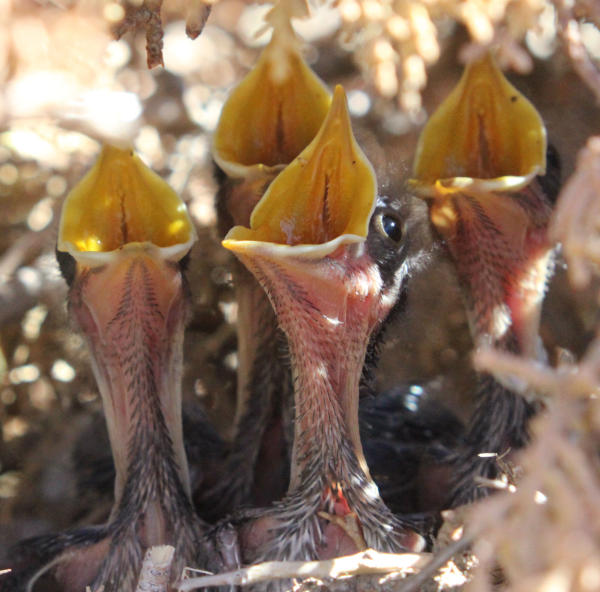
Northern Mockingbird

A nestful of Northern Mockingbirds.
|
One of the most storied songbirds, Northern Mockingbirds are best known for learning and repeating other species’ songs, other mockingbirds’ repertoires and some non-avian local sounds. Some mockingbirds are known to sing more than 150 different songs, a few have been documented with more than 200 different songs and all mockingbirds appear to continue to learn new songs throughout their lifetimes.
Several studies indicate that an expanded song repertoire improves the ability of a male to attract a mate, intimidate rivals and stimulate mates. Unmated males sing more than mated males, including singing during the night.
One study found that Northern Mockingbirds have two distinct repertoires of songs – one that they sing during spring, and a different one that they sing during fall. Even from spring to spring, the number of different songs used by an individual may only number one-third to two-thirds of the total songs used the previous spring – the rest are new songs.
Mockingbirds belong the thrasher family, Mimidae, “the mimics.” This Western Hemisphere family numbers 16 different species of mockingbirds, and another 20 species of thrashers and catbirds.
Pairs strongly defend their territory, nest, nestlings and fledglings, as evidenced by anyone with a mockingbird nest near their home, garage or office. Mockingbirds add a lot to our daily lives with their super-songs and active behaviors, even though we may take them for granted sometimes as just a common gray bird. Obviously, considering their remarkable ability to learn songs and develop song lines, these are some very special birds, indeed!
Range: From southern Maine to northern California south through Mexico. Mostly resident year-round, but they leave the northern tier of states during winter.
Habitat: Throughout most open landscapes including suburban yards.
Mating: Pairs are monogamous and form long-term pair bonds. Pairs may nest twice, and sometimes three times, per nesting season.
Nest Sites: Male and female build a flimsy nest of small sticks lined with grass, usually in a thick bush.
Clutch Size: 3 to 5 blue-green eggs marked with small and larger brown spots.
Incubation Period: Female incubates about 12 days.
Nestling Period: Male and female provide food and care for nestlings.
Fledging: About 12 days. The male feeds and cares for fledglings while the female begins re-nesting.
Food: Primarily small insects; sometimes berries.
Conservation Status: Common and widespread throughout their range. Northern Mockingbirds have been expanding their range northward during the past century, but declined during recent years in parts of their southern range.
Photographs by Paul Konrad